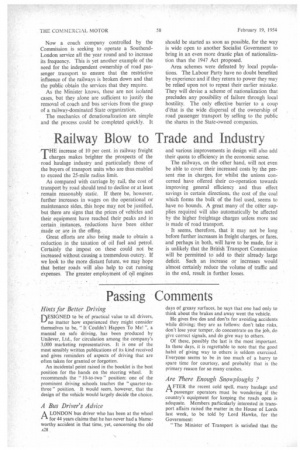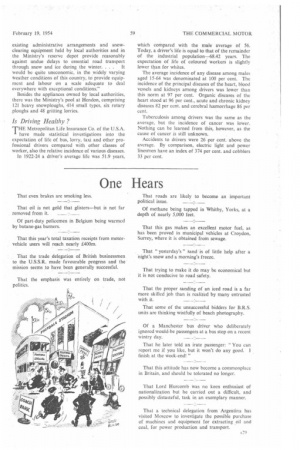Passing Comments
Page 30

Page 31

If you've noticed an error in this article please click here to report it so we can fix it.
Hints for Better Driving
nESIGNED to be of practical value to all drivers, no matter how experienced they might consider themselves to be, "It Couldn't Happen To Me! ", a manual on safe driving, has been produced by Unilever, Ltd., for circulation among the company's 3,000 marketing representatives. It is one of the most sensibly written publications of its kind received and gives reminders of aspects of driving that are often taken for granted or forgotten.
An incidental point raised in the booklet is the best position for the hands on the steering wheel. It recommends the 10-to-two" position: one of the prominent driving schools teaches the " quarter-tothree " position. It would seem, however, that the design of the vehicle would largely decide the choice.
A Bus Driver's Advice
ALONDON bus driver who has been at the wheel for 44 years claims that he has never had a blameworthy accident in that time, yet, concerning the old A28
days of greasy surfaces, he says that one had only to think about the brakes and away went the vehicle.
He gives five dos and don'ts for avoiding accidents while driving; they are as follows: don't take risks, don't lose your temper, do concentrate on the job, do give correct signals, and do give way to others.
Of these, 'possibly the last is the most important. In these days, it is regrettable to note that the good habit of giving way to others is seldom exercised. Everyone seems to be in too much of a hurry to spare time for courtesy, and probably that is the primary reason for so many crashes.
Are There Enough Snowploughs ?
AFTER the recent cold spell, many haulage and
passenger operators must be wondering if the country's equipment for keeping the roads open is adequate. Members particularly interested in transport affairs raised the matter in the House of Lords last week, to be told by Lord Hawke, for the Government: "The Minister of Transport is satisfied that the existing administrative arrangements and snowclearing equipment held by local authorities and in the Ministry's reserve depot provide reasonably against undue delays to essential road transport through snow and ice during the winter. . . It would be quite uneconomic, in the widely varying Weather conditions of this country, to provide equipment and labour on a scale adequate to deal everywhere with exceptional conditions."
Besides the appliances owned by local authorities, there was the Ministry's pool at Hendon, comprising 121 heavy snowploughs, 414 small types, six rotary ploughs and 48 gritting lorries.
Is Driving Healthy ?
THE Metropolitan Life Insurance Co. of the U.S.A. have made statistical investigations into the expectation of Life of bus, lorry, taxi and other professional drivers compared with other classes of worker, also the relative incidence of various diseases.
In 1922-24 a driver's average life was 51.9 years, which compared with the male average of 56. Today, a driver's life is equal to that of the remainder of the industrial population-68.42 years. The expectation of life of coloured workers is slightly lower than for whites.
The average incidence of any disease among males aged 15-64 was denominated at 100 per cent. The incidence of the principal diseases of the heart, blood vessels and kidneys among drivers was lower than this norm at 97 per cent. Organic diseases of the heart stood at 96 per cent., acute and chronic kidney diseases 82 per cent. and cerebral hxmorrhage 86 per cent.
Tuberculosis among drivers was the same as the average, but the incidence of cancer was lower. Nothing can be learned from this, however, as the cause of cancer is still unknown.
Accidents to drivers were 26 per cent. above the average. By comparison, electric light and power linesmen have an index a 374 per cent. and cobblers 33 per cent.




























































































